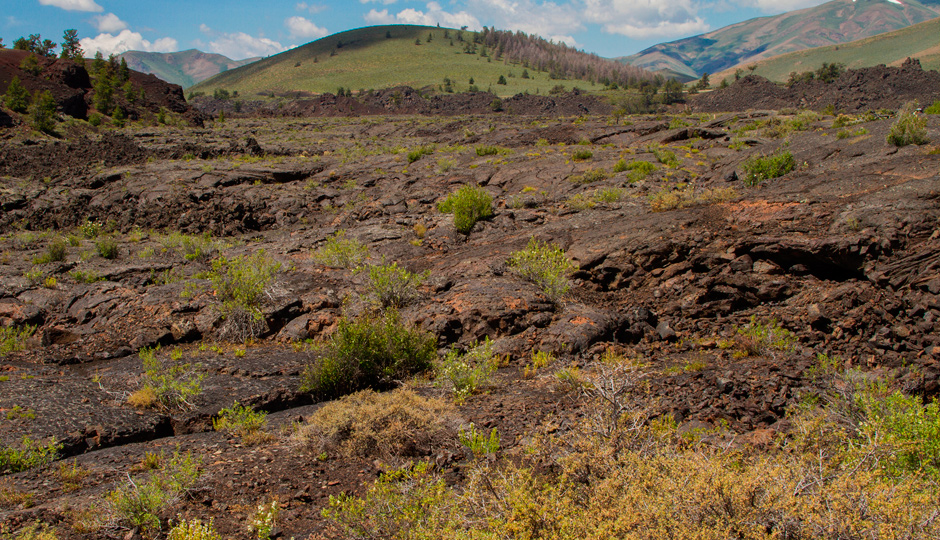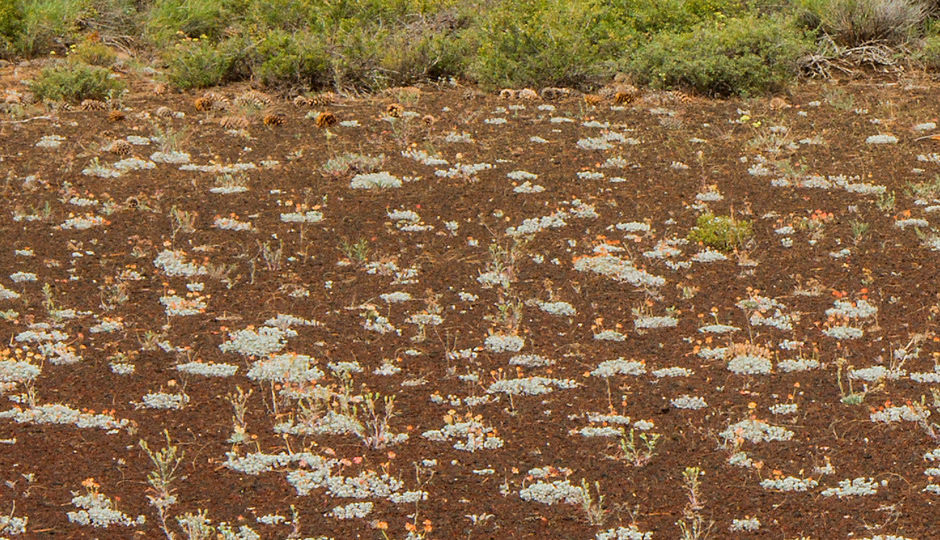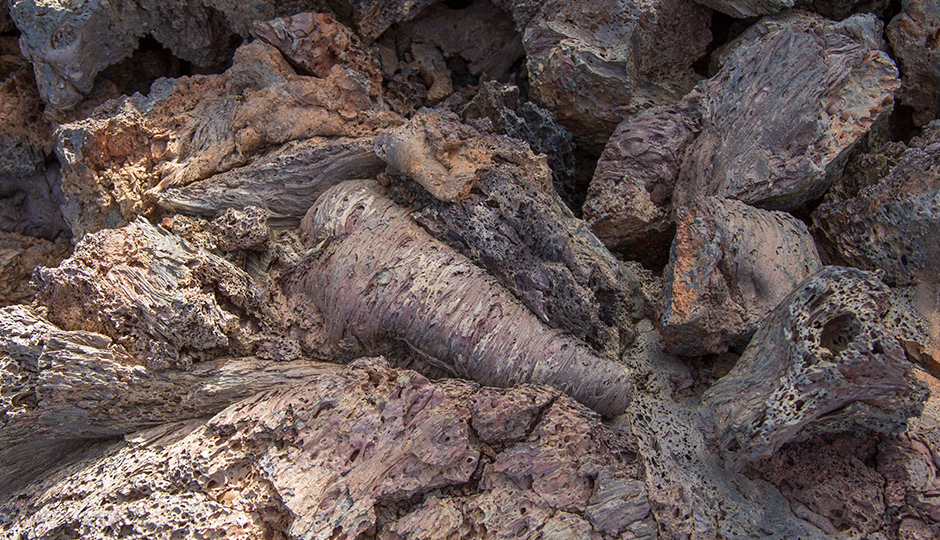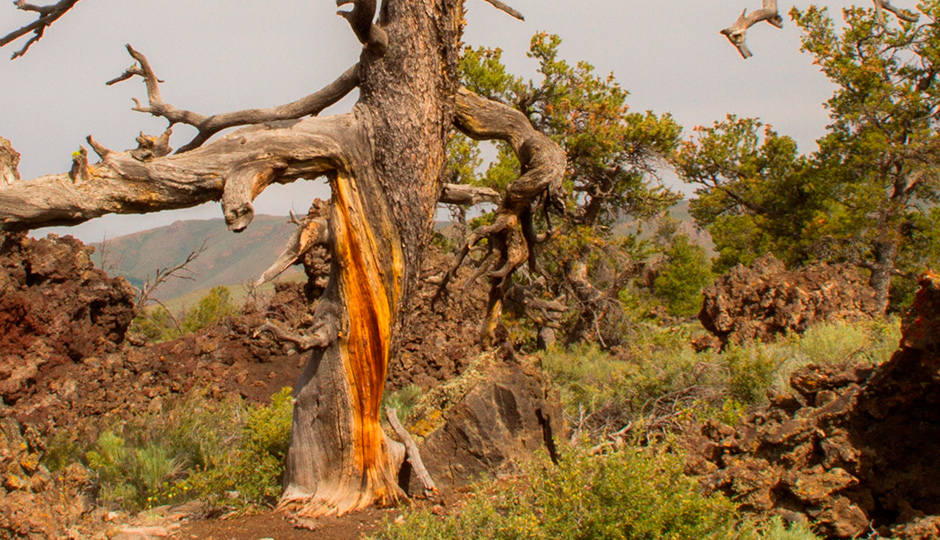


CRATERS OF THE MOON NATIONAL MONUMENT
photos (c) Helen Thayer
In July of 2019 Sam, my canine hiking partner and I traveled to central Idaho to visit the Craters of the Moon National Monument, a vast ocean of lava flows, islands of cinder cones and meadows of sagebrush. As we entered the Craters the amazing place began to unfold before us. Hiking would be limited because of the extreme abrasive nature of the lava and the National Park's pet restrictions. However, many interesting spots were still available and we took every opportunity to explore them and learn.
Learn More About Craters of the Moon [Page Two]
 Attractive sign welcomes visitors
Attractive sign welcomes visitors
From the visitor center, at an elevation of 5,004 feet, we first explored the North Crater Flow, one of the youngest lava flows in the Craters. Towering, reddish-black volcanic crater fragments had broken away from a volcano wall and had been pushed to their present location by the advancing lava flows. The 1,350 growth rings of a limber pine in the area allowed early geologists to estimate the age of the flow.
Patches of scorpion weed were growing in sheltered crevasses. Its silver haired leaves are adapted to reflect the hot sun. It is a "do-not–touch" plant as it can produce a painful skin rash - hence its name. A mock orange shrub was friendlier; its pure white flowers a contrast to the black surrounding lava.
Next we walked to an area named the Devil's Orchard. Not knowing what to expect in an area with such an ominous name, I discovered a place with so much diversity that I spent most of the day there.
 Typical lava flow landscape
Typical lava flow landscape
Ancient pines that had died and lay on the cinders among the volcanic crater wall fragments were scattered around. I thought of the long ago history of this place and what these ancient pines had experienced. Hidden among the fallen trees was a 5-foot high rock covered in colorful lichen proving that even a rough lava surface can provide a home for plant life. One of the most startling sights was lava that had hardened to resemble the bark of a tree.
Although the main spring flower season had passed, there were a few varieties still in bloom. One was the unlikely dwarf buckwheat. At first the evenly spaced clumps looked as if humans had deliberately planted them. However I discovered that the plant has a clever way of exploiting the available water by growing roots that spread out on all sides to cover an area much larger than its foliage, therefore discouraging other plants from becoming established in close proximity. This strategy produces the even spacing of these interesting, low growing plants. Its white leaves reflect the summer's hot sun.

Dwarf buckwheat
The yellow flowered sulfur buckwheat was a stark contrast to the reddish colored surrounding lava and grew on meager soil deposits among the rocks. It was a reminder that nature can find a way for plant life to survive even when there appears to be no soil at all.
After leaving Devils Orchard, Sam and I walked the road through meadows of sagebrush where enough soil had accumulated amid surrounding lava flows to allow desert plants to thrive. These areas called kipukas (an Hawaiian word), support sagebrush, steppe plants, and animal communities. Sage grouse make their home in these undisturbed havens of vegetation. Although I heard the nearby drumming sound of a sage grouse he remained hidden from view. This bird relies on sagebrush for its life cycle and protection from predators, making these kipukas important refuges. As we walked on, the drumming sound moved with us and stopped close to a castle like mountain of jagged lava. The still unseen grouse was following us, probably to ensure that we were actually leaving.
Next morning we headed in the direction of Inferno Cone. Inferno Cone was formed when gas laden volcanic froth erupted high into the air and then fell and cooled to form a giant mound of fine black cinders. This massive cinder cone at an altitude of 6,181 feet towers over the vast plains of the Craters. From here we could see the full extent of the Great Rift. The immense volume of lava that covers the Craters of the Moon did not result from one volcano, but instead issued from a series of deep fissures known collectively as the Great Rift and stretches over 50 miles across the Snake River Plain. 15,000 years ago lava welled from the Great Rift to produce the enormous ocean of lava that spread before us. The last eruptions are believed to have occurred 2,000 years ago. Scientists believe that more eruptions will occur within the next 1,000 years.

Giant upright chunk of lava
Later we followed the road to an area where I had a clear view of the chain of spatter cones. When lava loses most of its gas content it becomes less frothy and tackier, it is tossed out of the volcanic vent as globs of lava paste called spatter. The Monument contains one of the most perfect spatter cone chains in the world. The globs partially weld together to build up spatter cones. They are usually smaller than cinder cones with steeper sides and flatter tops. In the area around the spatter cones I discovered a fascinating variety of lava forms and shapes, generally consisting of rough, blocky, and abrasive lava. There were patches of lava that looked as if the surfaces had been sculptured by a human hand into artistic designs.

Sculpted by Nature
Later that afternoon as I followed the road on the way to the cave area, a great wall of gray rocks that had once held back a molten lake of lava confronted me. The rock barricade provided a natural dam that at first held back a fiery flow of lava. However, the force of hot lava overcame the rock dam and broke through and flowed across the valley engulfing all before it.

Spatter cone
At mid afternoon we crossed an area where a river of lava had flowed downhill and circled back under itself. As we approached, a chipmunk poked its head out from a deep crevasse in the lava, stopped to look at us, and then scurried to disappear into the depths of another crevasse. I looked down almost at my feet and saw a pink monkey flower that had pushed its way upward through the course gravel-like lava. Antelope bitter-brush shrubs were scattered about in full bloom. Tiny leaves prevent the loss of moisture in the hot sun. It's found on the older lava flows and although bitter tasting, the shrub provides food for browsing animals.
An extensive area of rough, abrasive aa lava (free chunks and angular pieces) covered the area close by. It was so rough that it would be impossible to cross without destroying even sturdy boots. I looked across the wide-open lava plain below that stretched to the horizon. Another cinder cone stood alone in the distance. From the high vantage point we could see a clear outline of the Great Rift from where this strange and otherworldly landscape had originated.
Sam and I descended the steep hill down to the kipukas, islands of sagebrush and limber pine that were a sharp contrast to the comparatively barren lava areas. As we walked downward vast views opened up. The place is so vast it's hard to absorb it all.

Twisted Limber Pine
Down on the plain below I found yet more strange lava shapes. The widespread variety in the way ancient lava had flowed and the forms and angles it created as it cooled and finally came to rest seemed endless. Now so quiet and peaceful, this plain was once a massive, explosive ocean of fire.
We continued our trek out of the main area of the Craters and headed west along the road that skirted the northern edge of the Craters lava fields that stretched south as far as the eye could see. The massive form of the cinder cone called Big Cinder Butte at 700 feet high and spread across an area of three square miles dominates the horizon. It is the largest cinder cone in the Craters and is one of the largest purely basaltic cinder cones in the world.
My visit to Craters of the Moon was an incredible experience. As I looked across the lava and cinder cone vistas - miles in every direction - I could only imagine what it must have been like when the earth opened up and pushed red hot lava across the landscape.
The Park Service has done a commendable job of preserving and making accessible this unusual, other-worldly environment, so that present and future visitors can understand the power of what once happened here.
Learn More About Craters of the Moon [Page Two]
Back to [National Parks Index]
